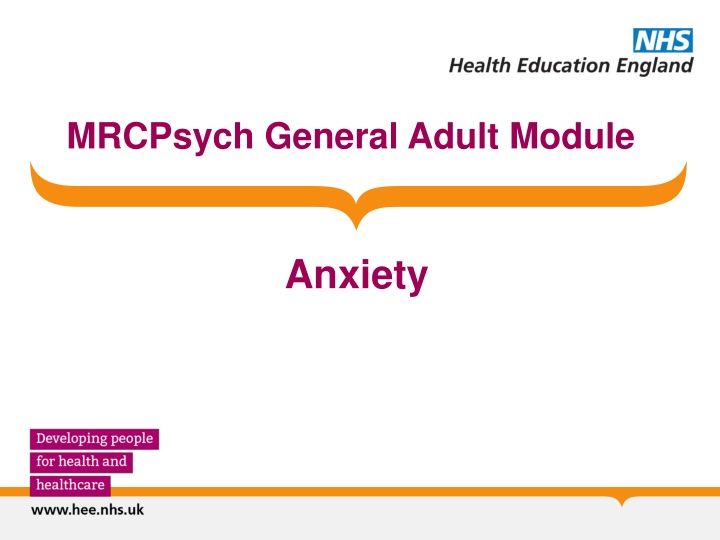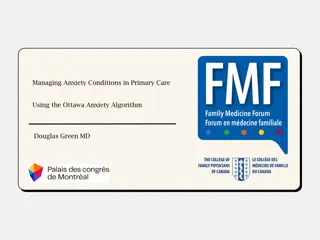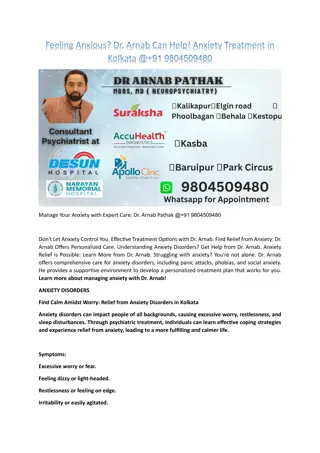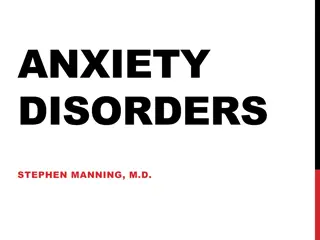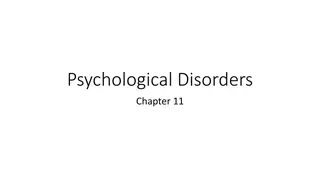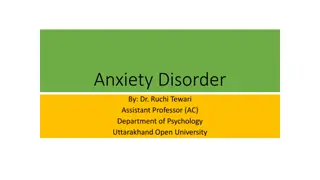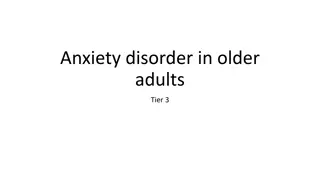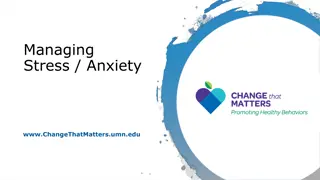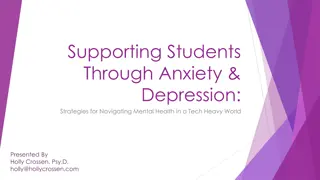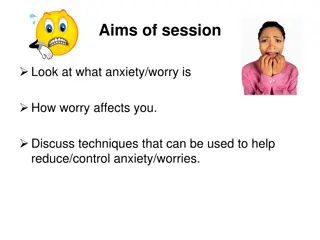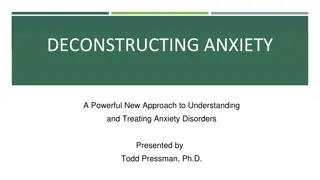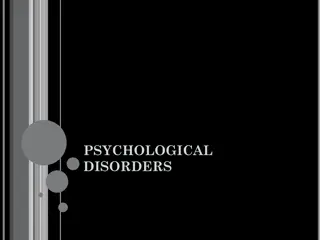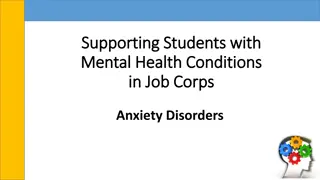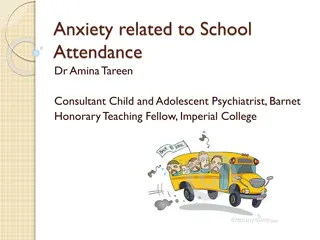Anxiety Disorders: Prevalence, Costs, and Aetiological Theories
Anxiety disorders are prevalent, leading to high costs and social problems. Explore the aetiological theories behind panic disorder, including serotonergic, noradrenergic, and genetic factors. Gain insights into the impact of anxiety on individuals' daily lives and the challenges of treatment.
Download Presentation

Please find below an Image/Link to download the presentation.
The content on the website is provided AS IS for your information and personal use only. It may not be sold, licensed, or shared on other websites without obtaining consent from the author.If you encounter any issues during the download, it is possible that the publisher has removed the file from their server.
You are allowed to download the files provided on this website for personal or commercial use, subject to the condition that they are used lawfully. All files are the property of their respective owners.
The content on the website is provided AS IS for your information and personal use only. It may not be sold, licensed, or shared on other websites without obtaining consent from the author.
E N D
Presentation Transcript
MRCPsych General Adult Module Anxiety
GA Module: Anxiety Aims and Objectives The overall aim is for the trainee to gain an overview of Anxiety By the end of the session trainees should: Develop detailed knowledge about aetiological theories and epidemiology Expert led session
GA Module: Anxiety Expert Led Session Anxiety: Aetiological Theories and Epidemiology
Image from RCPsych information leaflet for anxiety disorders, Illustration by Locole
Prevalence and Costs Anxiety disorders are among the most common mental disorders. Up to 15% of all people suffer during their life from an anxiety disorder (lifetime prevalence) (Kessler et al. 2010). Treatment of anxiety disorders and consequences of the disease cause high costs and are connected with severe social problems (Wittchen and Jacobi 2005). One in four patients with generalized anxiety disorder is not in a position to meet its daily life requirements (Becker and Hoyer 2000). The course of anxiety disorders without adequate treatment is chronic and recurrent and a spontaneous remission was found in only about 14% of the patients (Wittchen 1991).
Prevalence rates 12 month Prevalence Panic Disorder 0.6 3.1 Agoraphobia 0.1 3.1 GAD 0.2- 4.3 Social phobia 0.6 7.9 Specific phobias 3.1 -11.1 OCD 0.1 3.1 Median Panic disorder 1.2 Agoraphobia 1.2 GAD 2.0 Social Phobia 2.0 Specific Phobia 4.9 OCD 0.7
Panic Disorder Women 2-3 times more likely to be affected Age of onset : Bimodal distribution (15-24,45-54yrs)
Panic Disorder Aetiology Serotonergic model : exaggerated post-synaptic receptor response to synaptic serotonin Noradrenergic model: Increased NA activity, hypersensitivity of presynaptic 2 receptors GABA model: Reduced inhibitory receptor sensitivity Cholecystokinin-pentagastrin model, Lactate model: induce panic False suffocation CO2 hypothesis: hypersensitive brainstem receptors Neuroanatomical model: overactive fear brain network Genetic hypothesis: moderate heritability of 25-50%, stress- vulnerability Cognitive Theory: Fears about serious physical or mental illness are more frequent in anxious patients with panic attacks
Agoraphobia Women 3 times more likely to be affected Age of onset : Bimodal distribution (15-35,45-54yrs)
Agoraphobia - Aetiology Genetic and environmental: First degree relatives have increased prevalence of other anxiety, depressive disorders and alcohol misuse Psychoanalytical: Internal source of anxiety excluded by repression and attached to external object by displacement Learning theory : conditioned fear responses to learned avoidance
Simple Phobias Women 3 times more likely to be affected Mean age of occurrence is 15 yrs
Simple Phobia- Aetiology Genetic and environmental factors: MZ:DZ 26%:11% for animal phobia, situational phobia roughly equal suggesting stronger role of environmental factors Psychoanalytical: Internal source of anxiety excluded by repression and attached to external object by displacement Learning theory: association learning, fearful anticipation of phobic situations and selective attention to phobic stimuli
Social phobia Men > or = women Age of onset : Bimodal distribution, peaks at 5yrs and 11-15yrs
Social Phobia- Aetiology Genetic and Environmental factors: MZ:DZ= 24%:15% Dysregulation of 5-HT, NA and DA systems Neuroanatomical Model: Overactive fear brain network (prefrontal cortex, amygdala, hippocampus) Conditioning and Cognitive learning
GAD Women 1.5 to 2.5 times more affected than men Highest prevalence in 45-59yrs - 7.7%
GAD - Aetiology Triple vulnerability model Generalised biological vulnerability (genetic, neurobiological - 5HT, NE, GABA, HPA axis) Generalised psychological vulnerability (low sense of control, parenting and attachment issues) Specific psychological vulnerability (stressful life events, high threat events)
GAD Aetiology Genetic factors : there is a five-fold increased risk of GAD in first- degree relatives (parent, sibling and offspring) of people with GAD Environmental stressors such as domestic violence, unemployment, separation, low socioeconomic status, and history of child abuse are associated with the development of GAD Brain imaging studies in people with GAD have shown exaggerated responses in the amygdala and hippocampus (both involved in the regulation of emotion and behaviour) Alteration of GABA, serotonin, and noradrenaline have an apparent role in the pathophysiology of GAD
Neurobiology Cannon 1927- Thalamus plays central role in experience of emotions Papez 1937 neuronal circuit for experience of emotion Gray 1981- septohippocampal system is central substrate for anxiety in the brain , papez circuit +Locus coerulus + ANS Gorman 2000- neuroanatomical model for panic attacks
Neurobiology Vythilingam 2000: MRI studies show reduced temporal lobes but no change in hippocampal volume in panic disorder which is in contrast to findings in depression and PTSD Nutt 2001- In GAD, frontal cortex for worries, thalamus for hypervigilance , insula for autonomic sx, basal ganglia for motor tension Cannistaro and Rauch 2004: development of panic attacks by external cues that stimulate amygdala but person unaware
GA Module: Anxiety Any Questions? Thank you .. MCQs are next...
GA Module: Anxiety MCQs Which one of below is not true of body dysmorphic disorder (BDD)? A. First described by Morselli B. DSM-IV classifies BDD as a somatoform disorder C. ICD-10 classifies BDD under hypochondriacal disorder D. Severe BDD is usually treated with SSRI and CBT as first line E. Commonly associated with morbid jealousy.
GA Module: Anxiety MCQs Which one of below is not true of body dysmorphic disorder (BDD)? A. First described by Morselli B. DSM-IV classifies BDD as a somatoform disorder C. ICD-10 classifies BDD under hypochondriacal disorder D. Severe BDD is usually treated with SSRI and CBT as first line E. Commonly associated with morbid jealousy.
GA Module: Anxiety MCQs All of the following anxiety disorders are more common in females, except: A. Agoraphobia B. Social phobia C. Panic disorder D. Generalised anxiety disorder E. None of the above
GA Module: Anxiety MCQs All of the following anxiety disorders are more common in females, except: A. Agoraphobia B. Social phobia C. Panic disorder D. Generalised anxiety disorder E. None of the above
GA Module: Anxiety MCQs All of the below are poor prognostic factors for OCD, except: A. Early onset B. Male C. No compulsions D. Family history of OCD E. Longer duration
GA Module: Anxiety MCQs All of the below are poor prognostic factors for OCD, except: A. Early onset B. Male C. No compulsions D. Family history of OCD E. Longer duration
GA Module: Anxiety MCQs Which of the following is recommended by NICE as first line treatment for PTSD? A. SSRI antidepressants B. Counselling C. EMDR D. Combination of CBT and SSRI antidepressant E. Quetiapine
GA Module: Anxiety MCQs Which of the following is recommended by NICE as first line treatment for PTSD? A. SSRI antidepressants B. Counselling C. EMDR D. Combination of CBT and SSRI antidepressant E. Quetiapine
GA Module: Anxiety MCQs Which of the following statement is FALSE? A. Quetiapine has clear RCT evidence for efficacy in Generalised anxiety disorder. B. Escitalopram is licenced for treatment of OCD C. Treatment duration of at least 3 months is usually recommended for treatment of OCD D. Antipsychotics should not routine be combined with antidepressants for treatment of anxiety disorders E. Paroxetine, Escitalopram and Citalopram are all licenced for treatment of panic disorder
GA Module: Anxiety MCQs Which of the following statement is FALSE? A. Quetiapine has clear RCT evidence for efficacy in Generalised anxiety disorder. B. Escitalopram is licenced for treatment of OCD C. Treatment duration of at least 3 months is usually recommended for treatment of OCD D. Antipsychotics should not routine be combined with antidepressants for treatment of anxiety disorders E. Paroxetine, Escitalopram and Citalopram are all licenced for treatment of panic disorder
GA Module: Anxiety Any Questions? Thank you.
